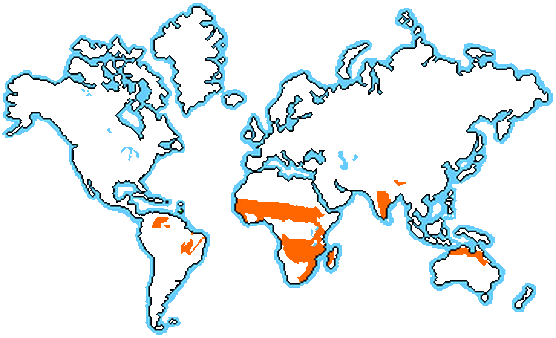Where in the WORLD are savannas?!
As you can see on the map, savannas are located inside and outside of the tropics, which gives them their other name: 'tropical' grasslands (the parts colored in orange are where the savannas are). They are bordered with mountains, woodland, seas, oceans, or deserts. They can be found mostly in Africa, Australia, South America, and the Middle East.
Savannas make up most of Africa - they actually make up almost half of the continent! In Australia, the savannas are located above the central deserts. On the Orinoco River basin (north of the Amazon) is the Llanos (meaning 'plain' in Spanish) Savanna of South America and on the south of the Amazon, is the Campos (meaning 'open pasture' in Portugese) Savanna. Another major savanna is the Deccan Plateau in India and the savannas of Australia.
Here is a short description of the major savannas:
Serengeti (Africa) - This is the largest type of savanna in the world. It consists of a extremely large variety of animals and is exactly the type of savnna you see in animations (tall orangish grass, flat topped trees, lions and giraffes).
Llanos (South America) - This type of savanna is made of 220,000 square-miles of grass land. In the rainy seasons, floods occur which enriches the soil. Five million cattle, horses, donkeys, and vast amounts of other animals live there.
Campos (South America) - Made up of two parts: campo cerrado (menaing 'closed field') and campo sujo (meaning ' dirty field'). More than 10,000 plants live in the campos and the campos make up almost 1/4 of Venezuela.
Deccan Plateau (India, Middle East) - This savanna is mostly natural but parts of it is 'artificial'. People burned forests or cut them down to make land for farming and building houses which sometimes created small savannas.
Australian Savanna (Australia) - This is where many marsupials (animals with pouches for their babies) live, such as the kangaroo, koala, wombat, and wallaby. The main tree that grows there is the Gum Eucalyptus, which is the main food source for koalas.
Savannas make up most of Africa - they actually make up almost half of the continent! In Australia, the savannas are located above the central deserts. On the Orinoco River basin (north of the Amazon) is the Llanos (meaning 'plain' in Spanish) Savanna of South America and on the south of the Amazon, is the Campos (meaning 'open pasture' in Portugese) Savanna. Another major savanna is the Deccan Plateau in India and the savannas of Australia.
Here is a short description of the major savannas:
Serengeti (Africa) - This is the largest type of savanna in the world. It consists of a extremely large variety of animals and is exactly the type of savnna you see in animations (tall orangish grass, flat topped trees, lions and giraffes).
Llanos (South America) - This type of savanna is made of 220,000 square-miles of grass land. In the rainy seasons, floods occur which enriches the soil. Five million cattle, horses, donkeys, and vast amounts of other animals live there.
Campos (South America) - Made up of two parts: campo cerrado (menaing 'closed field') and campo sujo (meaning ' dirty field'). More than 10,000 plants live in the campos and the campos make up almost 1/4 of Venezuela.
Deccan Plateau (India, Middle East) - This savanna is mostly natural but parts of it is 'artificial'. People burned forests or cut them down to make land for farming and building houses which sometimes created small savannas.
Australian Savanna (Australia) - This is where many marsupials (animals with pouches for their babies) live, such as the kangaroo, koala, wombat, and wallaby. The main tree that grows there is the Gum Eucalyptus, which is the main food source for koalas.

